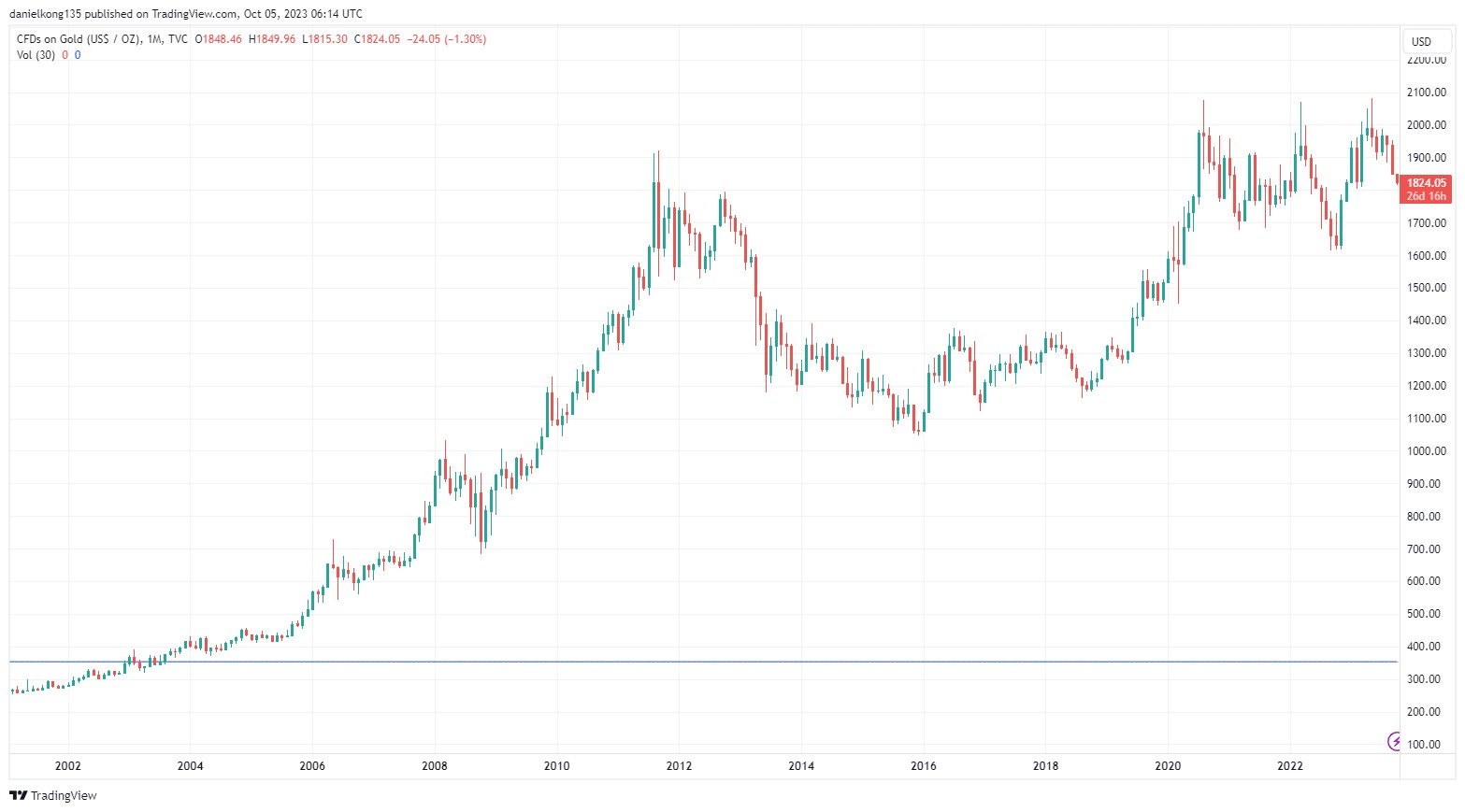Gold (XAU), a timeless symbol of wealth and stability, has held its allure for centuries. Its shimmering presence spans from the grandeur of ancient civilizations to the sleek gadgets of the modern world. As a trading asset, gold remains a cornerstone in the financial markets, offering investors a haven in times of economic uncertainty and a versatile instrument for diversification.
In this article, we embark on an in-depth exploration of gold trading, unraveling its historical significance, fundamental attributes, and contemporary trading strategies. Whether you're a seasoned trader or a curious beginner, this comprehensive guide will equip you with the knowledge needed to seize the golden opportunities that XAU presents.
Understanding Gold (XAU) in Financial Trading
Gold (XAU), often hailed as a "safe haven" asset, has consistently preserved its value during periods of market turmoil. Its enduring luster, captivating humans for centuries, continues to shine as a hedge against economic uncertainties.
What Gives Gold Its Intrinsic Value?
The intrinsic value of gold transcends modern economics, with roots stretching back to ancient civilizations. As early as 1500 BC, the Egyptians recognized gold's worth, elevating it to the status of the official medium of trade. This decision not only solidified its role in ancient commerce but also set a precedent for future civilizations. The introduction of the Shekel, an 11.3-gram gold coin, by the Egyptians became a standard measurement in the Middle East, underscoring gold's historical importance. In more recent history, the United States embraced the gold standard, directly linking the value of currency to specific gold reserves. This system endured until the 1970s, emphasizing gold's lasting impact on monetary policies and structures. The global trust in gold, evident across diverse cultures and eras, underscores its unmatched stability and value.

Gold Price Trends Over Time
Gold's price trajectory is a testament to its enduring appeal. Following the 2008 Global Financial Crisis and eurozone debt issues, gold consistently surged past $1,000, reaching a record high of $2,075 during the 2020 Covid-19 outbreak. Although there have been periodic fluctuations, such as a dip to $1,046 in December 2015 due to the strength of the U.S. dollar, geopolitical tensions and central bank demand have buoyed prices. Recent events maintained the precious metal above $1,800, with prices reaching $2,070 by March 2022. As of October 1, 2023, gold is trading at approximately $1,850 per ounce, though the World Gold Council warns of potential challenges ahead.
Diving Deeper into Gold Trading
What Makes Gold a Prime Trading Instrument?
Gold's resilience and historical significance make it a prime trading instrument. This precious metal, renowned for its unique properties and aesthetic appeal, has evolved from ancient vaults to modern-day investments. As we delve into gold's inherent qualities, its relevance in contemporary trading environments becomes increasingly clear.
- Investment Opportunity: Gold, a traditional symbol of stability, shines brightest during economic uncertainties. Its intrinsic value and global recognition position it as a robust shield against inflation and currency devaluation. When financial landscapes turn turbulent, seasoned investors turn to gold for its consistent preservation of value.
- Economical Role: Throughout history, gold has played a pivotal role in shaping the economies of countless civilizations. Beyond serving as a medium of trade, it has been a definitive measure of wealth and a foundational element of monetary systems. In today's world, its relevance is further underscored by the substantial gold reserves held by central banks, reaffirming its enduring importance in global economic structures.
- Rarity: One of the most captivating aspects of gold is its scarcity. This inherent rarity underpins its lofty value. Unlike renewable resources or commodities subject to annual production or harvest, gold's quantity on Earth is finite. Its limited availability, coupled with the complexities of mining and extraction, solidifies its position as a coveted material.
- Durability and Non-Corrosiveness: Among gold's many attributes, its durability and resistance to corrosion stand out. Unlike most metals, gold remains impervious to degradation. This enduring quality ensures gold's lasting allure, making it not only a dependable currency but also a centerpiece in jewelry and historical artifacts.
Why Trade Gold?
Gold has long been prized for its stability, especially during economic downturns. Its enduring value sets it apart from currencies susceptible to government decisions and inflation. Historically, gold has offered a sense of security and is often regarded as a safe haven asset during times of economic uncertainty. Incorporating gold into a trading portfolio provides diversification, as its performance typically differs from that of stocks or bonds, thus balancing potential risks and rewards. Furthermore, gold boasts high liquidity, making it easy to buy and sell. Investors can access gold through various investment products such as Exchange-Traded Funds (ETFs), Contracts for Differences (CFDs), options, and futures.
Trading gold also serves as a hedge against geopolitical uncertainties and currency fluctuations, adding to its allure for traders and investors alike.
Gold trading involves buying and selling gold to profit from its price fluctuations. Various methods are available, including gold Exchange-Traded Funds (ETFs) and Contracts For Differences (CFDs). CFDs, in particular, allow traders to benefit from gold's price movements without owning the physical metal. The value of a CFD is determined by the price difference between the trade's start and end, enabling traders to capitalize on both rising (long) and falling (short) gold prices.
Participants in the Gold Market
The gold market is a diverse landscape, accommodating individual retail traders, major institutional investors, central banks, and gold mining companies. Central banks play a crucial role by maintaining gold reserves as part of their monetary policy. Gold mining companies impact the market's supply, with their operations directly influencing gold prices. Gold traders, on the other hand, introduce liquidity into the market, responding swiftly to international events and economic trends, thus playing a pivotal role in price determination.
Gold can be traded in various forms, each with unique advantages. Physical gold, such as bars and coins, represents the most traditional method and is favored by those seeking tangible assets. Gold futures are contracts promising future delivery or cash settlement. Exchange-traded funds (ETFs) and derivatives, like CFDs, offer accessible avenues for individuals looking to trade gold without physical ownership. Gold certificates serve as proof of ownership without physical possession, enhancing transaction and storage convenience.
Gold Trading Instruments
A range of gold trading instruments caters to different trading objectives and risk profiles, offering traders multiple avenues to access the gold market.
- CFDs: Gold CFD trading has gained popularity over time, allowing traders to capitalize on gold price movements without owning the underlying asset. XAU CFDs, representing gold paired with major currencies, offer accessibility to the gold market. CFD trading on gold provides flexibility, enabling both short and long positions, but it's essential for traders to understand the leveraged nature of CFDs, which can amplify both returns and losses.
- Spot Markets: Spot markets facilitate immediate buying and selling of gold for immediate delivery. They represent the current market price of gold and offer a direct and straightforward trading approach. Transactions in the spot market typically settle within two business days, making it suitable for traders looking to respond quickly to market shifts.
- Futures Contracts: Futures contracts enable traders to buy or sell gold at a predetermined price on a set future date. These contracts offer a hedge against potential price fluctuations, appealing to those seeking predictability in their investments. Futures contracts can be traded on established exchanges, providing transparency, liquidity, and a standardized framework for traders.
- Options: Options grant traders the right, but not the obligation, to buy or sell gold at a specific price within a designated time frame. They offer flexibility, allowing traders to capitalize on price movements without physical ownership. Options can be used for hedging against adverse price shifts or capitalizing on market upswings while controlling risk.
- ETFs: Gold Exchange-Traded Funds (ETFs) provide an accessible avenue for investors to gain exposure to the gold market without owning physical gold. ETFs track the price of a basket of gold-related products and are traded on stock exchanges, combining the convenience of stock trading with the benefits of gold investment. They are ideal for those seeking lower capital investment and higher liquidity compared to physical gold ownership.
Gold (XAU) stands as a timeless symbol of wealth and stability, with a rich history that spans civilizations. In the realm of financial trading, it continues to hold its allure as a safe haven asset and a versatile instrument for diversification. Understanding the intricacies of gold trading, from its historical significance to its various forms and trading instruments, empowers investors and traders to navigate this precious metal's dynamic and ever-relevant market.
Whether you're drawn to gold for its intrinsic value, its role in economic history, or its potential for investment, this comprehensive guide equips you with the knowledge to unlock the golden world of trading and seize the opportunities that gold (XAU) presents.
Unveiling the Intricacies of Gold (XAU) Analysis: A Comprehensive Guide
Gold (XAU) analysis is a multifaceted domain, encompassing both fundamental and technical approaches, aimed at deciphering the intricate puzzle of gold price movements. It delves into the amalgamation of intrinsic and extrinsic factors that cast their shadows upon the enigmatic world of gold trading.
Fundamental Analysis of Gold (XAU)
Understanding the fundamental aspects of gold involves a deep dive into various factors that exert their gravitational pull on its value. These factors include a broad spectrum of economic, political, and societal elements, all capable of swaying gold prices. Key elements in gold fundamental analysis include:
- Central Bank Actions: Central banks wield considerable influence in the gold market. Their decision to sell or purchase substantial amounts of gold reserves can drastically impact the supply, potentially causing fluctuations in gold prices.
- US Dollar Value: Gold prices often dance to the inverse tune of the US dollar. When the dollar strengthens, gold prices may dip, and conversely, a weaker dollar often pushes gold prices higher.
- Interest Rates: The prevailing interest rates can significantly influence gold's value. Typically, as interest rates climb, gold prices may decline, as investors tend to seek assets with yield.
- Geopolitical Events: Major geopolitical happenings have the power to evoke fear among investors, driving them to seek refuge in gold as a safe haven asset, thus propelling its price upward.
- Jewellery and Industrial Demand: Gold's allure extends beyond the world of finance. Its demand in jewellery manufacturing and industrial applications can have a profound impact on its price. An increase in demand from these sectors can drive gold prices higher.
Technical Analysis of Gold (XAU)
Contrasting with fundamental analysis, technical analysis of gold zeroes in on price and volume data extracted from gold price charts. This method requires traders and investors to meticulously observe and analyze past price movements, employing a toolkit of tools and indicators like moving averages, trendlines, and chart patterns to predict future price trends.
For instance, if gold's price has been steadily climbing above its 50-day moving average, a technical analyst might interpret this as a bullish trend. Similarly, patterns such as the "head and shoulders" or the "double top" can suggest potential price reversals. In summary, while fundamental analysis seeks to fathom the underlying forces shaping gold prices, technical analysis endeavors to forecast future price trajectories based on historical trends and patterns.
Understanding Gold Pips
In the realm of gold trading, comprehending "Pips" is crucial. Pips, short for "Percentage in Point," are the smallest units used to denote changes in currency value. When it comes to trading gold, the definition of pips takes on a unique character. Here's how it operates: Gold price movements are often tracked to the fourth decimal place, meaning that a single pip corresponds to a change of 0.0001 in the gold price. For instance, if your forex broker uses a $0.01 gold pip, every pip movement in gold's price results in either a gain or loss of $0.01. This implies that 100 pips are equivalent to a $1 movement.
To compute the value from gold pips, you simply multiply the number of pips by the pip value. For example, if you earn 20 pips on a trade with a gold pip value of $0.01, your profit would amount to $0.20.
Gold Trading Strategies
Gold trading presents a myriad of opportunities, with various strategies designed to maximize returns while mitigating risks. Here are some prominent gold trading strategies:
- Long-Term Investment: A long-term investment approach in gold involves purchasing and holding onto the precious metal for extended periods, often spanning years or even decades. This strategy capitalizes on gold's historical role as a store of value and a hedge against inflation and economic downturns.
- Day Trading: Day trading in gold involves entering and exiting trades within a single trading day. Traders employing this strategy aim to capitalize on short-term price movements rather than long-term trends.
- Swing Trading: Swing trading centers on capturing price swings or movements over a short to medium time frame, typically ranging from a few days to a few weeks. Swing traders identify moments when gold prices may be poised for significant moves, either upwards or downwards.
- Seasonal Patterns: Gold, like many assets, can exhibit seasonal patterns based on various annual events, demand cycles, or historical trends. Seasonal pattern traders base their trades on predictable demand and supply changes during these recurring timeframes.
- Trend Trading: Trend trading involves identifying and following a clear trend in gold prices, whether it's bullish (upward) or bearish (downward). Traders employing this strategy rely on technical analysis tools, such as moving averages, to determine the direction and strength of prevailing trends.
Gold Trading Tips
Here are some essential tips to enhance your gold trading:
- Target Previous Highs and Lows: Previous price highs and lows often act as psychological markers for traders. These historical reference points can guide buy and sell decisions, particularly in the XAU/USD pair.
- Trade during New York Hours: Trading gold during New York hours can offer enhanced liquidity and substantial price movements, making it an ideal window for many traders.
- Use Symmetrical Triangles for Analysis: The symmetrical triangle pattern is a valuable tool in technical analysis, helping traders anticipate potential price breakouts in gold.
- Monitor Central Bank's Gold Purchases: Central banks' gold purchases can signal expectations of currency depreciation, potentially leading to short-term shifts in gold prices.
- Target Moving Average Crossovers: Moving average crossovers can provide insights into market momentum and potential buying or selling opportunities.
How to Trade Gold (XAU)
To trade gold (XAU), you can choose from various currency pairs, such as XAUUSD (gold against the US dollar) and XAUSGD (gold against the Singapore dollar). These pairs reflect how much of the respective currency is needed to purchase one ounce of gold. To get started, you'll need to open a trading account with a reputable broker. This account allows you to access the gold market and execute your trades. It's essential to select a broker that offers user-friendly platforms, reliable customer support, and educational resources to deepen your understanding of trading concepts.
In conclusion, gold (XAU) analysis is a complex but rewarding endeavor, blending the study of both fundamental and technical aspects. It offers diverse trading opportunities, and understanding key concepts, employing analytical methods, and choosing the right broker can pave the way for successful gold trading ventures.

















